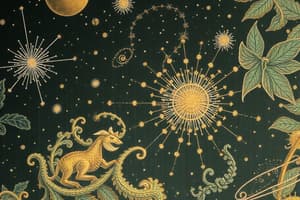Podcast
Questions and Answers
What occurs when a charged object is brought close to a neutral object?
What occurs when a charged object is brought close to a neutral object?
- The charged object loses its charge.
- The charges in the neutral object rearrange. (correct)
- The neutral object becomes permanently charged.
- The neutral object gains a charge.
Which of the following statements about series circuits is true?
Which of the following statements about series circuits is true?
- All components turn on and off together. (correct)
- Each bulb can be controlled independently.
- Series circuits require more power than parallel circuits.
- If one bulb burns out, the other bulbs remain lit.
What is the unit of power?
What is the unit of power?
- Volts (V)
- Watts (W) (correct)
- Ohms (Ω)
- Amperes (A)
What impact does increasing voltage have on current in a circuit?
What impact does increasing voltage have on current in a circuit?
In what way does bioamplification affect animals in the food chain?
In what way does bioamplification affect animals in the food chain?
What happens to the light of the moon during the waxing phase?
What happens to the light of the moon during the waxing phase?
What is the primary source of energy for ecosystems on Earth?
What is the primary source of energy for ecosystems on Earth?
How does charging by contact differ from charging by induction?
How does charging by contact differ from charging by induction?
What is the relationship between mass and number of particles in a substance?
What is the relationship between mass and number of particles in a substance?
Which statement accurately defines a chemical change?
Which statement accurately defines a chemical change?
How does the stability of an atom’s outer shell affect its behavior?
How does the stability of an atom’s outer shell affect its behavior?
What distinguishes a mechanical mixture from a solution?
What distinguishes a mechanical mixture from a solution?
What is the significance of conducting a Bohr Rutherford diagram for an atom?
What is the significance of conducting a Bohr Rutherford diagram for an atom?
Which of the following is true about protons in an atom?
Which of the following is true about protons in an atom?
Flashcards
Mass
Mass
The number of particles in a substance.
Volume
Volume
The amount of space an object takes up.
Physical Change
Physical Change
A change in the properties of a substance without forming a new substance.
Chemical Change
Chemical Change
Signup and view all the flashcards
Alloy
Alloy
Signup and view all the flashcards
Pure Substance
Pure Substance
Signup and view all the flashcards
Mixture
Mixture
Signup and view all the flashcards
Mechanical Mixture
Mechanical Mixture
Signup and view all the flashcards
Charging by Contact
Charging by Contact
Signup and view all the flashcards
Charging by Induction
Charging by Induction
Signup and view all the flashcards
Voltage (V)
Voltage (V)
Signup and view all the flashcards
Current (I)
Current (I)
Signup and view all the flashcards
Resistance (R)
Resistance (R)
Signup and view all the flashcards
Series Circuit
Series Circuit
Signup and view all the flashcards
Parallel Circuit
Parallel Circuit
Signup and view all the flashcards
Power (P)
Power (P)
Signup and view all the flashcards
Study Notes
Density
- Mass: The number of particles in a substance
- Volume: The amount of space an object occupies
- V = Length x Width x Height
Physical and Chemical Changes
- Physical change: Alters properties but no new substance is formed
- Chemical change: Alters properties and a new substance forms
Particle Theory of Matter
- All matter is made of tiny particles
- Particles of the same substance are identical
- Particles are always moving; faster with more energy
- Attractive forces between particles are stronger when closer together
Bohr Rutherford Diagrams
- Atoms are most stable when their outer shell is completely full or empty
Classification of Matter
- Alloy: A solution of two or more metals
- Pure substance: Composed of only one type of particle
- Mixture: Composed of at least two different types of particles
- Mechanical mixtures: Different particles are visible
- Solutions: Different particles are not visible
Electrical Nature of Matter
- Electrons can change, protons cannot
- Protons are heavy and located in the nucleus. Changing them needs extreme force
- Electrons are light and orbit outside the nucleus. Small forces (like friction) can affect their number
- Opposite charges attract; like charges repel
Charging by Friction
- Rubbing materials together can cause electrons to transfer
- Some materials hold electrons better than others
Charging by Contact
- A charged object touches a neutral object which transfers charge
Charging by Induction
- A charged object is near a neutral object, inducing charge movement in the neutral object
Voltage, Current, and Resistance
- Voltage (V): Energy per charge, measured in Volts
- Current (I): Charge flow per second, measured in Amperes
- Resistance (R): Opposition to current flow, measured in Ohms
Series and Parallel Circuits
- Series circuits: Components are connected one after another; not as bright; turn on/off together; less power; if one breaks, all break
- Parallel circuits: Components are connected across each other; brighter; switches can control individual components; more power; if one breaks, others stay on
Power and Energy
- Power: Rate at which a circuit element "does" something, measured in Watts (W)
- Energy: Total power accumulated, measured in Joules (J)
- Power = Voltage × Current
Energy in Ecosystems
-
All energy comes from the Sun
-
Sun → Producers → Herbivores → Carnivores/Omnivores
-
Carbon cycle:
- Photosynthesis absorbs carbon dioxide
- Respiration releases carbon dioxide
- Fossil fuels release stored carbon into the atmosphere.
-
Bioaccumulation/biomagnification: Toxins accumulate in living organisms (especially in top-level predators)
-
Solar System: Sun provides energy; Nuclear fusion generates heat and light in stars
- Tides are produced by the gravitational pull of the moon and sun.
Life Cycle of a Star
- Waxing: Light increase, star growing
- Waning: Light decrease, star shrinking
- Stars start as a stellar nebula, then grow and change based on their mass.
- Average stars become red giants, then white dwarfs
- Massive stars become red supergiants, then supernova, neutron stars, or black holes
Studying That Suits You
Use AI to generate personalized quizzes and flashcards to suit your learning preferences.




